|
Catchment Management in an urban area - case studies
of watercourse rehabilitation
Alfred
Bernhard
Bushland Manager
Willoughby City Council,
Sydney Australia
Clean water is the basis of life. The contrast between
water quality in the Sydney area two hundred years
ago and today is extreme. Urban development along
the ridges has created major degradation of waterways
in downstream areas. Urban runoff, as distinct
from sewage pollution, contains the oil, rubber and
heavy metals from roads as well as the detergents,
fertilizers and rubbish which is washed into our creeks
and harbour by the rain. In this way urban and
natural areas are directly linked. These impacts need
to be minimized and managed. It is vital to
treat the problem at the source rather than at the
endpoint.
 Education
programs, which increase community awareness of how
and why the problem is created and how it can be improved,
have been jointly funded by State and Local Government
and facilitated by programs such as ‘The Stormwater
Trust’. Education
programs, which increase community awareness of how
and why the problem is created and how it can be improved,
have been jointly funded by State and Local Government
and facilitated by programs such as ‘The Stormwater
Trust’.
Approximately A$20 million has been spent each year
for the past 4 years to implement projects identified
in regional Stormwater Management Plans. These
plans have sought to bring local Councils together
in Catchment groupings, such as Middle Harbour, an
area of approximately 100km2. Components
of the plans aim to improve water quality through
both structural and non-structural means.
Water quality monitoring can assist in evaluating
this work. Monitoring creeks using biological
indicators has been carried out using a survey of
macro invertebrates, which has allowed a ‘snapshot’
of the overall health of the waterways. The
larger the range, especially of sensitive species,
the better the water quality.
Physical improvements to watercourses in Middle
Harbour have included the restoration of concrete
channels or eroding creek embankments. Stabilisation
using sandstone, and revegetation using locally indigenous
species, have helped to restore natural stream flow
patterns and conditions. The improvement of habitat
has resulted in the return of some wildlife to these
areas.
 On a smaller scale this concept has been applied to
treat piped stormwater outlets to bushland areas.
Similar work has been carried out on some coastal
watercourses and lagoons, where the concentration
of pollutants in some cases has been very serious.
As an example we could cite the chemicals from a Golf
Course that recently killed thousands of fish in Manly
Lagoon. Siltation and lack of ocean flushing has also
caused major changes to lagoon quality.
On a smaller scale this concept has been applied to
treat piped stormwater outlets to bushland areas.
Similar work has been carried out on some coastal
watercourses and lagoons, where the concentration
of pollutants in some cases has been very serious.
As an example we could cite the chemicals from a Golf
Course that recently killed thousands of fish in Manly
Lagoon. Siltation and lack of ocean flushing has also
caused major changes to lagoon quality.
Education of the community is a prerequisite for
any improvement. Drain stenciling and school programs
are slowly increasing awareness of the impact of stormwater
problems.
Organisations such as the Sydney Coastal Councils
Group, the Sydney Harbour Catchment Management Board
and volunteer focused groups such as Coastcare are
working with local government to increase direct community
involvement with practical projects.
Cleaner water in all our creeks and lagoons is the
only acceptable outcome.

The Role of Local
Government in ecosystem restoration
Alfred Bernhard
Bushland Manager
Willoughby City Council,
Sydney Australia
The evolution of ecosystems has taken millions of
years.
As part of Gondwana, the ancient southern continent,
the sandstone of the Sydney basin was deposited over
200 million years ago. The flora had adapted to the
unique conditions while still revealing its ancestry.
The nutrient poor sandstone soils have resulted in
unique adaptions and numerous ecological communities.
The Araucaria is one link that reveals Brazil and
Australia’s ancient connection.
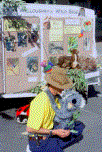 The divisions and boundaries created by States and
Local Government are unrelated to ecosystems. Plants
and animals can’t see them but are affected
by them. There are over 40 Councils in the Sydney
Harbour area. Most of the original vegetation has
been cleared, except for the steeper gullies and harbour
foreshore areas.
The divisions and boundaries created by States and
Local Government are unrelated to ecosystems. Plants
and animals can’t see them but are affected
by them. There are over 40 Councils in the Sydney
Harbour area. Most of the original vegetation has
been cleared, except for the steeper gullies and harbour
foreshore areas.
It is the role of Local Government to protect and
enhance what remains, often in conjunction with State
and Federal agencies.
In the Willoughby Council area key problems for
natural ecosystems are the result of urbanization,
such as clearing native vegetation, fragmentation
of natural areas, weed invasion, sewer overflows,
stormwater impacts, loss of fauna habitat, feral animals,
inappropriate fire regimes and domestic animals.
The Local Government Act requires the involvement
of the community in the preparation of Plans of Management
to address these and related issues. They provide
the detailed framework for on site works. Many
Councils now have an ‘Environment Officer’
and a ‘Bushcare Volunteer Coordinator’
to facilitate improved ecosystem restoration.
The support and participation of the community is
essential and close links to schools and community
organisations allow for more proactive environmental
education programs. Nevertheless most Councils
still have to take a big step in order to achieve
an appropriate balance between environmental and infrastructure
spending.
Regional co-operation between Councils on projects
such as the ‘Green Web’ will improve the
network of Green corridors within Sydney, while State
and Federal funding on projects such as ‘Greenspace’
and the Natural Heritage Trust have extended the scope
of ecosystem restoration work undertaken by Local
Government.
Labour programs such as the ‘Green Corps’
have provided training and initial employment to young
volunteers wishing to work in environmental projects.
At Willoughby Council the community has supported
an environmental levy, in addition to the usual Council
rates, in order to carry our restoration of watercourses,
community education, weed control and restoration
of endangered ecosystems. There is however still
a long way to go!
Sydney’s sense of place and its special environmental
characteristics deserve protection. Ultimately,
decisions by all its citizens, about lifestyle, energy
use and recycling as well as global environmental
awareness will determine whether that is possible.

Visitor Management
Emma Hayes
Bachelor of Business in Tourism
Willoughby City Council,
Sydney Australia
Studies of tourism trends for both the domestic
and international visitor show an "increased
desire for experiences that are authentic and incorporate
learning, rather than contrived entertainment"
(Commonwealth Department of Tourism, 1994 p.9.).
The word 'authentic' refers to the natural or cultural
environment of an area. Beautiful or distinctive
natural environments are attractive to tourists and
the general public for their distinctiveness. Natural
areas can fulfill a visitor’s sense of discovery,
need for escapism, and desire to experience 'nature'.
These areas can also instill a sense of patriotic
pride in the domestic and local visitor.
Protecting natural areas from visitor impacts is
essential for the survival of ecosystems and the economic
and social benefits derived from a tourism industry.
Ecotourism has been defined as "nature-based
tourism that involves education and interpretation
of the natural environment and is managed to be ecologically
sustainable." (Commonwealth Department of Tourism,
1994 p.3.)
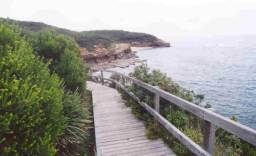 Fragile natural areas
are often not suited to the trampling effects of visitor’s,
often creating irreversible damage to the environment. Fragile natural areas
are often not suited to the trampling effects of visitor’s,
often creating irreversible damage to the environment.
Managing the natural areas most at threat from visitors
can be costly and complicated, however the loss of
natural resources is a far greater price to pay. A
realistic ecotourism strategy is vital to restrain
an industry that can easily damage the resources on
which it depends.
Consultation and input from all levels of government,
environmental associations, the retail and tourist
industry, community and education groups, recreational
users and tourists is required. The principal
aim of the discussion being - to protect ecosystems
while providing access to a range of activities or
sites where visitors can interact with the natural
environment and be satisfied by what nature has to
offer.
Consultation from within the local community can
help create designs, ideas and activities that are
original and distinct from those found in other regions
or the rest of the world. Including protective structure
design i.e. tracks and viewing platforms, managed
recreational and educational activities that fit specifically
into the natural area and enhance the experience for
the visitor. Retaining authenticity, distinction and
a 'sense of place' for locals and visitors alike.
Reference: National Ecotourism Strategy published
by the Australian Commonwealth of Tourism 1994.

Environment and Art
Jacqueline Lawes
Artscape - Artspace - Artplace Precis
This illustrated talk highlights the innate value
of the beauty of the Australian bush (landscape) and
the ability of artists to encapsulate this. I believe
their interpretation grows from a passionate link
to a particular place. This is the case across all
cultures.
The art of the Aboriginal people of Australia is
one of the longest continuous traditions of art in
the world dating back at least fifty millennia. Art
is central to Aboriginal life and expresses individual
and group identity and the relationships between people
and the land. Art activates the powers of the ancestral
beings.
For example the 'Wandjina' - a group of ancestral
beings who come out of the sky and sea. They bring
rains, control the elements and maintain the fertility
of the land and natural species. They are extremely
important and are portrayed with such beauty. They
continue to be a source of inspiration today.
When the Europeans came to Australia they imposed
their European painting styles on the Australian landscape
as they came to terms with its difference. Official
artists recorded historical events and botanical discoveries.
Over time more sympathetic and essentially Australian
styles evolved resulting in portrayals of the Australian
Landscape as places of beauty and diversity. The link
again was made between man and his environment.
The Heidelberg school of impressionists painters
- Streeton, Roberts and McCubbin gained inspiration
and provided wonderful depictions of many landscapes
- they camped all over the country enjoying the bush
and its diversity and we enjoy the fruits of their
creativity. The vision of artists such as Fred Williams'
has greatly altered has altered the way in which we
see the country around us.
Artists have also been frontrunners in the environmental
protection movement. Hans Heysen became an ardent
defender of the eucalyptus tree. He was also a very
talented painter and illustrated to all the innate
beauty of these glorious trees in a way that only
artistic reproduction can. In 1930s Albert Namatjira,
Australia's first popularly known Aboriginal painter
began painting with European materials and styles.
His work historically served as a translation between
styles of the two different cultures and was seen
as evidence that supported the assimilation policy
of the time. Because of this respect for his work
was diminished in artistic circles. Posthumously,
however, it is now recognised that his subjects were
not inspired by the European aesthetic but by the
expression of his personal relationship to his spiritual
country.
This essential and dynamic connection with the land
for Aboriginal people continues and is portrayed by
modern aboriginal artists in a great diversity of
styles. Modern artists of both cultures continue this
distillation of the sense of place made possible by
the sheer existence of the beauty and diversity of
our environment. Not only is there such diversity
of landscape in Australia to inspire artists but also
a great diversity of artistic styles which can illustrate
the innate significance of this landscape and reinforce
society's awareness of the need to protect it.

Rehabilitating Sub-tropical
Rainforest
Jenny Ford
Bushland Regenerator
A sub-tropical rainforest area in Northern New South
Wales known as the Big Scrub originally covered 75
000 hectares. It has now been reduced to less than
1% of primary rainforest due to clearing, logging,
agriculture, mining, housing and recreational activities.
The remaining areas are degraded due to the loss of
structure, microclimate, changes in hydrology, isolation
and weed invasion.
Weeds are amongst the biggest threats to the long-term
survival of sub-tropical rainforest remnants and plantings.
They suppress the natural processes of succession,
flowering, fruiting and the diversity of food sources
and habitat required by fauna.
Before work commences on a site, it is recommended
that a detailed site assessment be undertaken, thus
giving a clearer understanding of all the issues faced.
Aspects to look at in this initial process include
the health of native vegetation (eg. the structure,
strata’s, gaps in the canopy, species over/under
represented); Weed species present (eg. their distribution,
habit, reproductive cycles, how they are affecting
the ecosystem); Other impacts (eg. drying winds, adjoining
land use, access, erosion, feral animals).
Once these points are well understood then a Plan
Of Management can be written and adopted. This type
of document should include a map showing a variety
of features, the aim and objectives of the restoration
project, the methodology required, priorities and
species lists. It allows workers to move in the same
direction, can be used as a reference and may assist
with acquiring funding.
The control of exotic species is often an essential
component of an effective programme. A philosophy
known as the Integrated Approach has proven to be
the most successful for the rehabilitation of rainforest
remnants in the north of N.S.W. It simply means taking
the whole system into account – weeds and all!
Weeds may be providing valuable microclimate, habitat,
and food sources for fauna.
‘Target weeding’ one particular species
may create an environment susceptible to the invasion
of other exotics, sometimes more detrimental to the
local system than those you are attempting to control.
The varieties of problems often require a variety
of solutions involving herbicide and non-herbicide
techniques. Apart from weed control, it may also involve
erosion control, limiting access to an area through
fencing and signage, formulating pathways or the planting
of local species.
Whatever the methods chosen, it is important to
work in zones always consolidating on previous works,
rehabilitating the understorey before controlling
larger woody weeds in the canopy, maintaining a closed
edge, and never creating an area too large to maintain.
It is also essential to re-visit previously worked
areas to conduct follow up weeding as well as continuing
to observe the results of your work.
By documenting all works on a day-to-day basis
and referring to the plan of management, we ensure
that the best work is carried out and that we continue
to learn about the regenerating process.

The Care Movement
Louise Brodie
AABR
Care for the environment is carried out at a number
of levels in Australia. The last 15 to 20 years has
seen a growth in community involvement in caring for
land, water and vegetation. This involvement has developed
from two directions.
There has been a grass roots movement in the community
to become involved in caring for land and vegetation
and the formation of groups to carry out land restoration
work.
The second "top down" approach has resulted
in government agencies supporting groups with both
funding for materials, and for staff to assist in
coordinating these groups and provide expertise. This
has largely developed with the recognition of professionals
working in the field, that repair and sustainability
of the environment will only be successful if the
community is involved.
A major popular movement is the Landcare movement.
This is Australia wide with groups working in both
urban and rural areas on both public and private land.
The movement commenced when official support of local
groups was undertaken by the Government of the state
of Victoria, in 1986. In 1990 this spread over all
Australia, when an alliance between a conservation
group, the Australian Conservation Foundation, and
the National Farmers Federation lead to the federal
government declaring the Decade of Landcare and providing
funding to support groups. These groups work at repairing
degraded land, restoring and conserving native vegetation
and watercourses. They are supported with funding
for materials and the provision of co-coordinators
who provide assistance and access to expertise. There
are now more than 4,500 landcare groups across Australia.
About one in every three farmers is a member of a
landcare group.
A subset of this in NSW is Coastcare. This evolved
from Dunecare which began when the state agency responsible
for the erosion of coastal systems facilitated the
formation of groups to work in these areas.
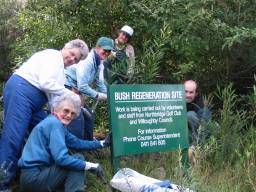 In urban
areas, especially Sydney and surrounds, Bushcare is
another program. Once again this movement commenced
when professional recognised the need for neighbours
of bushland areas to become involved in keeping those
areas healthy. In the main these are neighbourhood
bushland parks, which are managed by local councils.
Local government funds the support of these groups.
In the Sydney region, there are over 4,000 volunteers
in Bushcare groups. There are also programs for individual
landholders who wish to conserve native vegetation
and wildlife. In urban
areas, especially Sydney and surrounds, Bushcare is
another program. Once again this movement commenced
when professional recognised the need for neighbours
of bushland areas to become involved in keeping those
areas healthy. In the main these are neighbourhood
bushland parks, which are managed by local councils.
Local government funds the support of these groups.
In the Sydney region, there are over 4,000 volunteers
in Bushcare groups. There are also programs for individual
landholders who wish to conserve native vegetation
and wildlife.
A subset of this in NSW is Coastcare. This evolved
from Dunecare which began when the state agency responsible
for the erosion of coastal systems facilitated the
formation of groups to work in these areas.
In urban areas, especially Sydney and surrounds,
Bushcare is another program. Once again this movement
commenced when professional recognised the need for
neighbours of bushland areas to become involved in
keeping those areas healthy. In the main these are
neighbourhood bushland parks, which are managed by
local councils. Local government funds the support
of these groups. In the Sydney region, there are over
4,000 volunteers in Bushcare groups.
There are also programs for individual landholders
who wish to conserve native vegetation and wildlife.

The role of
integrated coastal management and public policies
in the sustainable development
Marinez Scherer Widmer
Coastal Management – Instituto Ambiental Ratones
 To cope
with problems of increasing human pressure in coastal
zones and potential ecological impacts on coastal
ecosystems, better coastal zone management is required.
Many countries and groups of countries have been developing
and implementing coastal zone management initiatives
for the last decade. Sustainable development, with
the participation of different stakeholders in the
decision making process, is the main objective of
integrated coastal zone management (ICZM). Because
ICZM is acclaimed as one of the best initiatives to
minimize human impacts in the coastal area, one would
expect it to have a strong ecological and biological
basis. To cope
with problems of increasing human pressure in coastal
zones and potential ecological impacts on coastal
ecosystems, better coastal zone management is required.
Many countries and groups of countries have been developing
and implementing coastal zone management initiatives
for the last decade. Sustainable development, with
the participation of different stakeholders in the
decision making process, is the main objective of
integrated coastal zone management (ICZM). Because
ICZM is acclaimed as one of the best initiatives to
minimize human impacts in the coastal area, one would
expect it to have a strong ecological and biological
basis.
However, after analyzing Brazilian ICZM initiatives,
such as its national Coastal Management Program (GERCO),
it becomes clear that they lack strong ecological
and biological guidance. This tendency was also observed
in other Brazilian bills, plans, projects and programs
regarding the coastal zone. This pattern is not exclusive
to Brazil. The lack of detailed ecosystems description,
an almost complete lack of carrying capacity definition
in relation to human activities and poor determination
of ecological, biological and environmental indicators
for monitoring purposes, are evident at all levels
of managerial initiatives, from international to local
government.
For ICZM to be effective and to move towards sustainable
development, it is necessary to increase our understanding
about the physical, chemical and biological characteristics
of the coastal zone. To achieve that, more basic research
should be supported. An increased use of this knowledge
by Brazilian coastal managers, in conjunction with
extensive public participation, should also occur.

Environmental Education
for Children
Nadia Lalak
Environment educator - Willoughby City Council, Sydney
Australia
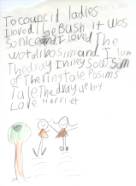 Willoughby Council
has a dynamic and expanding Schools’ Environmental
Awareness and Bushland Education Program, which is
coordinated from Council, but implemented in the schools
and local community. Willoughby Council
has a dynamic and expanding Schools’ Environmental
Awareness and Bushland Education Program, which is
coordinated from Council, but implemented in the schools
and local community.
The aim of the Program is to raise environmental
awareness of urban bushland and catchment issues utilising
local resources. This provides the students with opportunities
for direct experience with the natural world whilst
forging links between schools and their local bushland
reserves and waterways. The Program supports the longer-term
objective of involving community in the management
of our bushland reserves.
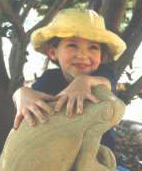 The
Program is in line with a recent Department of Education
–Environment Education Policy for Schools –
which aims to instil in children awareness and the
capability to contribute to the care of both the local
and global environment. This policy states that environmental
education has a spiritual focus, inspiring an emotional
and sensitised response from people, not only in their
appreciation of the wonders of the natural world,
but making them feel at one with the environment. The
Program is in line with a recent Department of Education
–Environment Education Policy for Schools –
which aims to instil in children awareness and the
capability to contribute to the care of both the local
and global environment. This policy states that environmental
education has a spiritual focus, inspiring an emotional
and sensitised response from people, not only in their
appreciation of the wonders of the natural world,
but making them feel at one with the environment.
Hands-on experience is the key in environmental
education.
he majority of activities are field trips in
the form of bushwalks to local reserves – ranging
from 2 hours to a whole day. Topics may be linked
to specific units of work in the curriculum syllabus
or lend themselves to cross-curriculum application.
A sense of fun is incorporated so that children have
an enjoyable experience which assists in an emotional/positive
connection with nature. A worksheet and suggested
follow-up activities are organised to consolidate
awareness and learning.
Other diverse activities in reserves
or at school are:
- Propagation workshops (locally collected native
seed)
- Concept plans of school grounds
- Indigenous plantings within school playgrounds
- Spray-stencilling stormwater drain pits in CBD
with
Environmental messages
- Environmental street theatre
- Interactive displays using WCC Bushcare Trailer
at schools
- Rudimentary water testing in local creeks / Bug
Survey
- Clean-up pollution in creeks
- Environmental competitions (eg Weed Busters)
- Display children’s Environmental artwork
in Library, Shopping areas, Council Reserves
- Assistance with Environmental Grant Applications
- School Staff Bushwalks
What we are trying to do is familiarise children
with their local natural environment, so they will
be at ease within their natural world and have a sense
of connection to it.
What happens when children get out into the natural
environment?
They are excited ... ready to marvel... to experience
awe... full of wonder and delight...
With children the appearance of wildlife invariably
inspires such responses. A lizard just
there in the bushes...
a frog, so still, so camouflaged...
a tawny frog-mouthed owl silhouetted on the branch
of a gum tree...
a ring-tail possum dozing in a tree with tail
curling through the nest...
a spider delicately weaving its web...
and is that fairy dust sprinkled on the leaf litter…..perhaps
there is a bush fairy nearby...
All of these have an impact...
And once there is a sense of connection, there
is more than a momentary link the beginnings of a
lasting relationship – with this particular
place and with nature in general.
In the course of children’s education it
is important to provide repeated opportunities for
nature to work its magic.

Development of an
Ecological Restoration Educational Program
Rowan Hayes
Consultant Landscape Planner
This presentation is about the process that led
to development of formal education programs in ecological
restoration. In Australia we called these ‘Bushland
Regeneration’ programs.
The beginning of the restoration movement in Australia
started in the 1970s when a group of volunteering
women working on small, almost domestic scale recovery
projects, established a series of important ecological
principles suited to the Sydney environment. The main
problems they faced were urban run-off and rampant
exotic weed invasion.
By the 1980s, the volunteers had been joined by
a workers union movement and enlightened professional
environmentalists. This led to a demand for formal
technical education to train workers who could continue
with the pioneering work of the volunteers.
Beginning at the School of Horticulure in Sydney,
it was necessary to develop a new range of study through
a syllabus that was more holistic than the traditional
courses in urban horticulture and ‘gardening’
skills. Advisory committees counseled educators to
develop a specific course in ecological restoration.
This course has been highly successful and strongly
supported. In the past 2 decades, participation in
educational programs has grown from a few enthusiastic
volunteers to more than 500 per year. One Technical
College in Sydney has 200 enrolled students this year.
Today education and on-ground
action work together to promote behavioural change,
raised awareness and mainstream employment for trained
technicians and operators. Technical education has
contributed to a growing change in community attitudes
and a new, Australian-wide, environmental restoration
industry is now well established. |